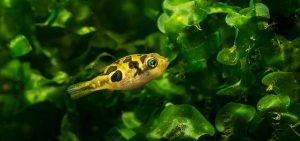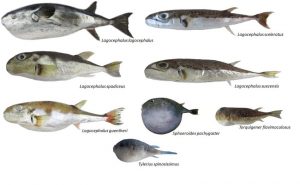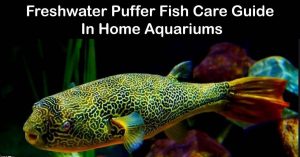Freshwater pufferfish is becoming a popular pet among fish owners. This chubby fish with a peculiar face and dark spots on its body gives a unique look to any aquarium.
Sure, they can be a challenge to keep but definitely very rewarding for experienced fish keepers.
These fish get their name from the knack to puff up and double their size when in danger. Because of the increase in size, their spines become more prominent.
This effectively stops any predator from attacking or eating pufferfish. They’re also famous for their venom: tetrodotoxin, toxic for most fish species.
Continue reading if you want to know more about freshwater pufferfish. This write-up contains all the information about pufferfish types, temperament, compatibility, water requirements, and more!
You will also learn where to find and give them the best possible care.
In-Depth Information of the Freshwater Puffer Fish

General Puffer Fish Facts:
- Care Level: Advanced
- Temperament: Aggressive
- Color Form: Colorful
- Lifespan: 10+ Years
- Size: 1 to 24 inches
- Family: Tetraodontidae
- Diet: Omnivorous
- Minimum Tank Size: 10 gallons
- Tank Set-Up: Freshwater
- Compatibility: Best kept alone
Origins, Lifespan, and Size
Pufferfish is a freshwater species found all over the world. Some species of pufferfish also dwell in brackish and marine. Its natural habitat is rivers in South America, South Asia, and some African regions.
As it’s a tropical and subtropical fish, it prefers to stay in warm waters.
The average lifespan of pufferfish is 10 years. However, it can vary depending on the tank conditions, the diet you provide, and overall fish health.
A freshwater puffer can live even longer if you provide the most suitable conditions and meet all of its requirements.
As for the size, an average Pufferfish grows anywhere from 1 to 24 inches. Their size depends on the living conditions as well as pufferfish species type.
There are over 100 pufferfish varieties, and their size varies accordingly.
Species and Temperament
There’s a wide variety to choose from when it comes to species and types of pufferfish. There are more than 150 pufferfish and 30 freshwater puffer varieties.
Whichever species you pick for your tank, ensure that you understand fishkeeping because all of its species are high-maintenance.
Pufferfish is extremely territorial. Its temperament can be extremely hostile and aggressive towards other species (including invertebrates). It can pose a challenge in a multi-fish aquarium.
Therefore, you will need a separate tank for freshwater pufferfish. But, if you can keep a separate tank, having a freshwater puffer can be extremely rewarding.
Most Popular Types of Freshwater Puffer Fish

As we mentioned earlier, freshwater pufferfish comprises 30 different types. Let’s talk a bit about the most popular freshwater puffer varieties.
1. Congo Pufferfish
As you can tell by that name, Congo pufferfish come from the waters of Africa. They grow approximately 6 inches in length, come in multiple colors, and spend most of their time hiding at the bottom of the aquarium. They need a bigger tank and are extremely sensitive to nitrates.
2. Dwarf Pufferfish
Aka Pea pufferfish or Pygmy pufferfish is one of the smallest pufferfish varieties in the world. It grows to one and a half inches only.
This breed is trendy among aquarists because of its popping bring colors and tiny size. You can easily find a suitable tank and filtration for dwarf pufferfish than any other variety.
3. Fahaka Pufferfish
The Fahaka Pufferfish is among the largest and most aggressive puffer species. It can grow to a maximum length of 16 inches, making its upkeep a bit challenging.
These fish require at least a 60 inches long aquarium with strong filtration capabilities. Not just that, you will also have to plant some dense vegetation to provide them with enough food.
4. Golden Puffer
The Golden Puffer comes in two varieties. The dark version has a black body and yellow dots, while the lighter version has a white body and yellow dots.
These fish have a round body with tiny fins set far back. Golden puffers are also among the largest of the type, growing as large as 20 inches under the right living conditions.
5. Imitator Puffer
AKA the Dwarf Malabar or Indian Pufferfish is another common small pufferfish species. It has a bright yellow complexion – more in males than females.
An adult imitator grows just one inch in length. It’s a very active and intelligent little fish, swimming in a unique pattern that makes it a sight to behold.
Freshwater Puffer Fish Care Guide

If you want to keep your pufferfish healthy for a long time, you should know how to maintain it best.
Below are some necessary arrangements:
1. Food & Diet
Give your pet pufferfish a balanced diet. As puffers are omnivores, they can have anything and everything. Their favorite food is meat. This includes snails, crustaceans and shellfish, etc.
They can also eat other fish – even whole. Whether frozen, dry or live, pufferfish will eat anything. Therefore, you should keep some diversity in what food you provide.
Their feed will also depend on the type and size. Each species of freshwater puffer comes with its own eating habits. Check their diets as per requirements before you put one in your tank. Similarly, size determines how often you should feed it.
Feed smaller pufferfish (under 2 inches in length) only once daily. Medium-sized pufferfish (from 2 to 4 inches) require a feed on alternate days. Finally, larger pufferfish (4 inches or more) require feeding only two to three times a week.
There’s one thing to remember, though. A peculiar thing about these fish is that their teeth keep growing throughout their lifespan.
So, you should, sometimes, feed them hard substrate animals. These can be shellfish, snails, or crustaceans. It will help check the growth of your pet’s teeth.
2. Tank Size Requirement
You need to understand the housing requirements for different freshwater puffer species for optimal health. As each species has a different size, their tank size differs accordingly.
Below is a quick overview of the tank size requirement.
| Specie | Tank Size |
| Dwarf Puffer | At least 10 gallons |
| Imitator Puffer | At least 10 gallons |
| Red Tailed Dwarf Puffer | At least 10 gallons |
| South American Puffer | At least 40 gallons |
| Congo puffer | At least 40 gallons |
| Crested Puffer | At least 55 gallons |
| Golden Puffer | At least 125 gallons |
| MBU Puffer | At least 500 gallons |
Generally, it’s better to just get a slightly larger tank than their requirements. This will ensure there’s minimal waste.
Note: These size requirements are for one pufferfish per tank.
3. Habitat and Water Requirements
Try to create a natural habitat for these tropical fish as much as possible. Keep the same water hardness (8 to 12 dKH), pH levels (between 7 to 7.6), and current they find in natural habitats of Africa, South America, and South Asia.
This way, it will feel more comfortable in your aquarium and live a long, happy life.
Freshwater pufferfish are prone to exterior parasites, allergies, and diseases. They are also pretty sensitive to nitrates, nitrites, ammonia, and bad water conditions. Therefore, you should keep powerful filters in your aquarium to maintain regular water parameters and keep it clean.
If possible, invest in a double filtration system that comes with lighting and heating.
4. Tank Mates
Because of aggressive behavior, freshwater pufferfish don’t go well with other fish or invertebrates in general. Some puffer varieties can even eat other mates. Keep only one pufferfish per tank. However, you can keep some other mates depending on your puffer variety.
For instance, Kuhli Loach goes well with MBU puffer and Golden puffer. Similarly, fancy guppies can be a good mate for the red-tailed dwarf puffers, Pea puffers, and golden varieties. Likewise, Otocinclus Catfish can be a good option for Golden and red-tailed dwarf puffers.
5. Breeding
Breeding freshwater pufferfish is a bit difficult because of their aggressive territorial nature. However, it’s not impossible if you are already familiar with the species. The exact breeding details may differ according to each type.
Still, generally, you have to provide them with ideal feed, mate, and living conditions for extended periods.
The breeding process usually begins with the male puffer chasing the female until she accepts his advances. Together they will move to a spot under the cover of thick plants to do their thing.
Nevertheless, once you find a suitable pair and breed, it isn’t always easy to raise the fry. They are very protective of eggs but sometimes eat them once the eggs hatch.
Final Thoughts
So, that’s all about the freshwater pufferfish. They are challenging to keep in captivity (even a baby pufferfish can be very aggressive), but keeping puffers can be very rewarding once you get the hang of the hard work.
These fish possess very peculiar shape and hunting techniques, making them quite a sight to behold. We hope this comprehensive guide provides you with all the information you need to care for them. Good luck!

